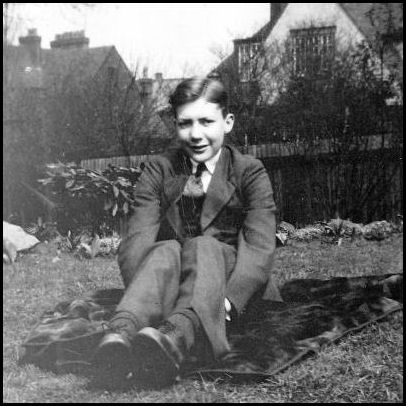Chapter 1 - Volunteer Service
 |
Stephen Fraser Smith and twin sister, Elisabeth Margaret, were born on 15th January 1917 to parents Clara Jane Smith and William Henry Smith. They had two older brothers, Philip (born 5/4/06), andWilliam Stewart (born 1/12/12). Stephen's death in 1943 would have been even more cruel for his parents who had previously lost a daughter, Mary, (born
18/5/09, died 15/10/09) following an infected smallpox vaccination. They had
also lost a son, Geofrey Forster, (born 14/9/01, died 15/12/21) following a
climbing accident which resulted in gangrene in one leg.
The picture shows the twins, Stephen and Eleizabeth Margaret at about age four.
|
|
His father ran the family business of J& H Smith which sold ironmongery and hardware etc. in Leeds. Stephen grew up at the family home Pelton Cottage, Manley Grove, Ben Rhydding, near Ilkley
in Yorkshire. Unlike his brothers who were educated at Ilkley Grammar School, Stephen was sent to Pocklington School near the city of
York between 1928 (age 11) and 1934 (age 17). School records show that
throughout his time at Pocklington he became an accomplished actor, and enjoyed
swimming and rugby football. In rugby he went on to represent his school in the
First 15 team.
This picture shows Stephen in 1932 (age 15) in
the garden at Pelton Cottage |
|
 |
School records [27] indicate that other membersof the team were also to die in war. Team captain, E.G. Petrie was killed in the Spanish civil war. Pietro Giovetti joined the RAF and died in September1941. His grave is in South Kyme, Lincolnshire. Asheliegh Thorpe trained as adoctor rising to the rank of Captain in the Royal Army Medical Corps. He was
killed in 1943 in Sicily.
(Image kindly provided by Pocklington School) |
|
His elder brother, Philip, emigrated in 1928 to become a farmer in Kenya whilst Stephen and his brother William were intended to take over the running of the family business.
War, however, was to intervene.
This image shows Stephen in 1935 with his baby nephew, Geofrey, and his parents |
|
At 11 a.m. on September 3rd 1939 Prime Minister Chamberlain declared war with Germany as from 5 p.m. that day.
Within twenty four hours the RAF bombed German warships at the entrance to the Kiel Canal. The war in
Europe was to continue until May 8th 1945 while hostilities against Japan were
to continue until VJ day on 2nd September. In those fateful six years an
estimated 55 million lives were lost. RAF Bomber Command lost 55,573 crew
members [1]. In addition, bomber crews who flew from bases outside Britain also
suffered significant losses. Just one of those who perished was Stephen
Fraser Smith.
By 1940
Britain had experienced the "phoney war" and it was becoming
increasingly obvious that the country might be invaded. There were calls for a
defence force to be established (later to become known as the Local Defence
Volunteers then the Home Guard). The Battle of France officially ended when
Prime Minister Winston Churchill, in his famous "This was their finest
hour" speech in June, went on to say that "I expect that
the Battle of Britain is about to begin".
Like so many
of his contemporaries and possibly inspired by a sense of national duty or
perhaps hoping for adventure, Stephen volunteered for service in the Royal Air
Force. Aged 23, he enlisted as an Aircrafthand/SP (Service number 991606)
on the 4th April 1940 at Number 3 Recruitment Centre, Padgate near Warrington.
Doubtless disappointed, but until his training could start, he was immediately
placed on the reserve. His Statement of Service [2] shows that he
attended Number 9 Recruitment Centre, Blackpool on 28th August.
He was then
recorded as being sent on 21st September to Number 4 Radio Servicing School
at Madley near Hereford and, just five months later, being posted as a ground tradesman to 73 Signals
Wing on 17th February 1941. This unit was subsequently renamed No 4 Radio Maintenance Unit and, on 6th February 1941 to
No 73 Signals Wing. It would seem, then, that the two entries in
Stephen's record referred in fact to just one posting. No 4 Signals Unit
was established at RAF Church Fenton, near Tadcaster in Yorkshire, to care for
technical servicing of Chain Home and Chain Home Low radar sites at Danby
Beacon (Yorks), Stenigot (Lincs), Staxton Wold (Yorks), Bempton (Flamborough,
Yorks), Easington (probably Spurn Head), Skendleby (Lincs). It initially
employed one officer and 31 'other ranks'. As its role grew it soon
outlived its on-station accommodation and on 19th August 1940 took up residence
in a large country house namely "the Towers" in the nearby village of
Barkston Ash. Still growing, but now as 73 Signals Wing, Stephen's unit
set up a new headquarters at Easthorpe Hall which was taken over from its then
owner Lady Grimthorpe.
Stephen's
Statement of Service lists him as RAF VR which means he had volunteered for
aircrew service. On 21st July 1941 he was listed as Under Training as an
Observer at Number 1 Aircrew Reception Centre [2]. This was seemingly at
Regents Park in London. He was then transferred to Number 2 Initial Training
Wing on 23rd August. On 29th November he was promoted to Leading Aircraftman.
No 2 Initial Training Wing (Renamed from No 1) was based at Cambridge.
"Cadets" as the entrants were known for reasons of morale, were first
processed through the Receiving Centre for 2 weeks before a further 8 weeks
within Initial Training. They received instruction on such subjects as
Discipline, General Service, and technical training in Mathematics, Navigation,
Armaments and Signals.

